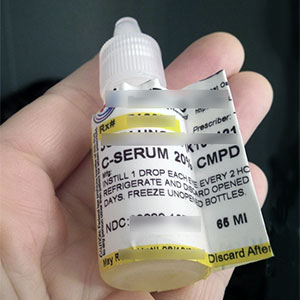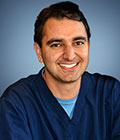- Home
- Resource Library
- Dry Eye Resources
- ASEDs (autologous serum eye drops for dry eye)
ASEDs (autologous serum eye drops for dry eye)
Introducing ASEDs: dry eye drops derived from your own blood!

If you suffer from dry eye syndrome, you may already be familiar with the frustration of trying to manage your symptom of a shortage of your own natural and vital tears.
Unfortunately, there are a number of patients who fail to obtain symptom relief despite trying one or more artificial tears, ointments, eyelid hygiene regimens, collagen tear duct plugs, or laser treatment options for the lacrimal glands to boost their natural tear production.
If you are one of those patients who have failed to find long-lasting relief, we invite you to consider autologous serum eye drops (ASED).
What are autologous serum eye drops?
The use of autologous serum eye drops (ASEDs) dates back to 1975, when they were first used to treat chemical burns of the eye. ASEDs are made from serum -- a component of your blood that is combined with sterile saline to create a lubricating fluid rich in certain nutrients and growth factors that may be missing in very dry eyes. The term autologous means that it comes from your own body.
ASEDs are highly effective, well-tolerated, and have ingredients that artificial tears just can’t replicate but which promote healthy growth and healing of the ocular surface (called the cornea). Some of the ingredients in ASEDs that are found in natural tears but which aren’t available in artificial tears include antibodies, albumin, Vitamin A, and special growth factors important for healthy eyes, known as epidermal growth factors.
Note that ASEDs are not tear substitutes and are often used in conjunction with other treatment modalities, such as artificial tears, DELIT, punctal plugs, in patients requiring more advanced eye treatment.
Do autologous serum eye drops work?
In our patients with moderate to severe dry eye disease, we have found that ASEDs often help their eyes feel better, see better, and, in persons with damaged or operated corneas, heal better.
While a number of theories have been floated as to why ASEDs help dry eye patients who’ve failed to improve significantly with other therapies, the truth is that no one is exactly sure how the drops work. At AGEI, we believe it may have something to do with the fact that eye drops made from your own blood contain a lot of albumins (a natural protein also found in eggs) which creates a higher quality, protective tear film for the corneal epithelial cells (surface cells).
In addition to improving the quality of a patient’s tear film, we’ve observed that using the serum for the eyes helps improve the health of the delicate nerves on the eye’s surface. Because we've found that the beneficial effect of artificial tears has its limitations, we sometimes administer ASEDs to improve the healing potential of the ocular surface before and after certain surgeries, such as corneal transplants and vitrectomies.
How are eye drops made from my own blood cells?
The process for making lubricating eye drops via your own blood collection is pretty simple and convenient. A very small amount of your blood is drawn at our office by a professional technician using a sterile technique and strict quality controls. This takes about 15 minutes and doesn’t require fasting.
The blood is then placed into a centrifuge and separated into its components. The blood serum is collected, combined with sterile saline and divided into many small dropper bottles. The serum-to-saline ratio may vary according to your doctor’s assessment of the severity of your dry eye disease. This process takes up to three hours, so we give you the option of returning later that day to pick up your vials or coming back the following day. You leave with a several-month supply of drops, depending on your dosing frequency.
The prepared eye drops are placed in the freezer to maintain optimal freshness and retard the growth of harmful microorganisms for up to 6 months. We instruct our patients to thaw one vial at a time in their refrigerator for daily use. A vial should last for several days if the eye drops are applied four times daily. Because the eye drops are preservative-free, once opened, a thawed vial should be used within 30 days.
Rest assured that AGEI utilizes only professional phlebotomists trained in drawing and handling blood products and uses sterile equipment dedicated exclusively to the preparation of eye drops.
You are given written instructions with safe storage and eye drop usage instructions to ensure that there’s no confusion in how to use your drops for the best results. Most patients notice an improvement in symptoms as soon as 2 weeks from beginning ASED therapy.
How effective are autologous serum eye drops?
ASEDs have shown to be fairly effective in treating moderate to severe dry eye over the 20 years since its introduction and has had few known adverse events. Serum drops have been used to treat a wide range of ocular surface diseases: from severe dry eye syndrome caused by rheumatoid arthritis, Sjogren's syndrome, keratitis, or keratoconjunctivitis sicca, to moderate temporary dry eye symptoms following LASIK surgery. Because these eye drops are derived from the patient's own blood as opposed to that of blood donors, there is no risk of eye drop rejection (known as graft versus host disease).
Because serum drops are used to treat a range of ocular surface disorders, there have been few randomized, controlled studies performed using a large number of subjects having one specific diagnosis. What's more, since these drops are custom-made from the patient's own tears and not manufactured, no clinical trials have been possible. As such, this treatment does not currently have FDA approval.
Nonetheless, specialty ophthalmology groups such as the American Society of Cataract and Refractive Surgery, the Tear Film and Ocular Surface Society, and the International Task Force on Dry Eye all recommend ASEDs to treat moderate to severe dry eye based on their members’ success in treating dry eye symptoms with ASEDs.
What do autologous serum eye drops cost?
One of the reasons that ASEDs aren’t widely used is that they are not covered by most health insurance since this treatment does not have FDA approval. And this treatment is costly because it requires the preparation of a custom medication using each patient’s blood.
The blood must be drawn by a technician, prepared using special equipment, and then stored frozen. Most ophthalmology practices refer patients to get blood drawn at an outside facility that sends the blood to a compounding pharmacy which then prepares the eye drops. This adds more inconvenience and expense to the process. Finally, after starting the eye drops, you need to return to your eye doctor's office for follow-up visits to see how your treatment is progressing.
At AGEI we simplify the process by doing the blood draws and preparing the eye drops on-site so that our patients can get everything done in one visit. Many of our dry eye patients who've had limited relief from other treatment modalities have had life-changing symptom improvement from serum drops and feel that keeping their eyes healthy is a worthwhile investment.
Why treat your dry eye symptoms at Assil Gaur Eye Institute?
AGEI has had great success in treating dry eye sufferers using a wide variety of treatment modalities, including the state-of-the-art DELIT, cyclosporine, and other medications, artificial tears, and punctal plugs, among others. We are happy to be one of a few Los Angeles area practices offering autologous serum eye drops, providing our patients with convenient on-site blood draws and same-day formulation of autologous serum tears in our state-of-the-art facilities.
If you are experiencing dry eye symptoms that affect your daily quality of life, contact us to make an appointment for an examination and consultation with one of our ophthalmologists. Please call 866-945-2745 or click here to make an appointment online.
We are conveniently located for patients throughout Southern California and the Los Angeles area at locations in or near Los Angeles, Beverly Hills, Santa Monica, and Culver City.
-
Dr. May is an optometrist who has worked with Dr. Assil and the Assil Gaur Eye Institute for over a dozen years . He provides a broad range of care for patients including pre and post-surgical management, comprehensive eye exams, urgent care as well as dry eye consultation and therapy. He's also assisted in numerous FDA supervised clinical trials run at AGEI.














